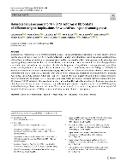| dc.contributor.author | Urban, Lukáš | |
| dc.contributor.author | Čoma, Matúš | |
| dc.contributor.author | Lacina, Lukáš | |
| dc.contributor.author | Szabo, Pavol | |
| dc.contributor.author | Sabová, Jana | |
| dc.contributor.author | Urban, Tomáš | |
| dc.contributor.author | Šuca, Hubert | |
| dc.contributor.author | Lukačín, Štefan | |
| dc.contributor.author | Zajíček, Robert | |
| dc.contributor.author | Smetana, Karel | |
| dc.contributor.author | Gál, Peter | |
| dc.date.accessioned | 2023-12-12T13:40:36Z | |
| dc.date.available | 2023-12-12T13:40:36Z | |
| dc.date.issued | 2023 | |
| dc.identifier.uri | https://hdl.handle.net/20.500.14178/2112 | |
| dc.description.abstract | Identification of therapeutic targets for treating fibrotic diseases and cancer remains challenging. Our study aimed to investigate the effects of TGF-β1 and TGF-β3 on myofibroblast differentiation and extracellular matrix deposition in different types of fibroblasts, including normal/dermal, cancer-associated, and scar-derived fibroblasts. When comparing the phenotype and signaling pathways activation we observed extreme heterogeneity of studied markers across different fibroblast populations, even within those isolated from the same tissue. Specifically, the presence of myofibroblast and deposition of extracellular matrix were dependent on the origin of the fibroblasts and the type of treatment they received (TGF-β1 vs. TGF-β3). In parallel, we detected activation of canonical signaling (pSMAD2/3) across all studied fibroblasts, albeit to various extents. Treatment with TGF-β1 and TGF-β3 resulted in the activation of canonical and several non-canonical pathways, including AKT, ERK, and ROCK. Among studied cells, cancer-associated fibroblasts displayed the most heterogenic response to TGF-β1/3 treatments. In general, TGF-β1 demonstrated a more potent activation of signaling pathways compared to TGF-β3, whereas TGF-β3 exhibited rather an inhibitory effect in keloid- and hypertrophic scar-derived fibroblasts suggesting its clinical potential for scar treatment. In summary, our study has implications for comprehending the role of TGF-β signaling in fibroblast biology, fibrotic diseases, and cancer. Future research should focus on unraveling the mechanisms beyond differential fibroblast responses to TGF-β isomers considering inherent fibroblast heterogeneity. | en |
| dc.language.iso | en | |
| dc.relation.url | https://doi.org/10.1007/s00418-023-02221-5 | |
| dc.rights | Creative Commons Uveďte původ 4.0 International | cs |
| dc.rights | Creative Commons Attribution 4.0 International | en |
| dc.title | Heterogeneous response to TGF-β1/3 isoforms in fibroblasts of different origins: implications for wound healing and tumorigenesis | en |
| dcterms.accessRights | openAccess | |
| dcterms.license | https://creativecommons.org/licenses/by/4.0/legalcode | |
| dc.date.updated | 2024-01-25T08:10:33Z | |
| dc.subject.keyword | Carcinoma | en |
| dc.subject.keyword | Hypertrophic scar | en |
| dc.subject.keyword | Keloid | en |
| dc.subject.keyword | Melanoma | en |
| dc.subject.keyword | Stroma | en |
| dc.subject.keyword | Tumor microenvironment | en |
| dc.relation.fundingReference | info:eu-repo/grantAgreement/MSM//LX22NPO5102 | |
| dc.relation.fundingReference | info:eu-repo/grantAgreement/UK/COOP/COOP | |
| dc.relation.fundingReference | info:eu-repo/grantAgreement/FN/V-FN/V-VFN | |
| dc.date.embargoStartDate | 2024-01-25 | |
| dc.type.obd | 73 | |
| dc.type.version | info:eu-repo/semantics/publishedVersion | |
| dc.identifier.doi | 10.1007/s00418-023-02221-5 | |
| dc.identifier.utWos | 001068040600002 | |
| dc.identifier.eidScopus | 2-s2.0-85171287101 | |
| dc.identifier.obd | 635760 | |
| dc.identifier.pubmed | 37707642 | |
| dc.subject.rivPrimary | 30000::30200::30204 | |
| dc.subject.rivSecondary | 30000::30100::30106 | |
| dc.subject.rivSecondary | 10000::10600 | |
| dcterms.isPartOf.name | Histochemistry and Cell Biology | |
| dcterms.isPartOf.issn | 0948-6143 | |
| dcterms.isPartOf.journalYear | 2023 | |
| dcterms.isPartOf.journalVolume | 160 | |
| dcterms.isPartOf.journalIssue | 6 | |
| uk.faculty.primaryId | 110 | |
| uk.faculty.primaryName | 3. lékařská fakulta | cs |
| uk.faculty.primaryName | Third Faculty of Medicine | en |
| uk.faculty.secondaryId | 108 | |
| uk.faculty.secondaryId | 53 | |
| uk.faculty.secondaryName | 1. lékařská fakulta | cs |
| uk.faculty.secondaryName | First Faculty of Medicine | en |
| uk.faculty.secondaryName | Všeobecná fakultní nemocnice v Praze | cs |
| uk.faculty.secondaryName | Všeobecná fakultní nemocnice v Praze | en |
| uk.department.primaryId | 110 | |
| uk.department.primaryName | 3. lékařská fakulta | cs |
| uk.department.primaryName | Third Faculty of Medicine | en |
| uk.department.secondaryId | 1503 | |
| uk.department.secondaryId | 627 | |
| uk.department.secondaryId | 1488 | |
| uk.department.secondaryId | 5000002589 | |
| uk.department.secondaryId | 100025448551 | |
| uk.department.secondaryName | Dermatovenerologická klinika 1. LF UK a VFN | cs |
| uk.department.secondaryName | Department of Dermatology and Venereology | en |
| uk.department.secondaryName | Klinika popáleninové medicíny 3. LF UK a FNKV | cs |
| uk.department.secondaryName | Department of Burns Medicine 3FM CU and UHKV | en |
| uk.department.secondaryName | Anatomický ústav 1. LF UK | cs |
| uk.department.secondaryName | Institute of Anatomy | en |
| uk.department.secondaryName | Dermatovenerologická klinika 1.LF a VFN | cs |
| uk.department.secondaryName | Dermatovenerologická klinika 1.LF a VFN | en |
| uk.department.secondaryName | BIOCEV 1. LF UK | cs |
| uk.department.secondaryName | BIOCEV | en |
| dc.description.pageRange | 541-554 | |
| dc.type.obdHierarchyCs | ČLÁNEK V ČASOPISU::článek v časopisu::původní článek | cs |
| dc.type.obdHierarchyEn | JOURNAL ARTICLE::journal article::original article | en |
| dc.type.obdHierarchyCode | 73::152::206 | en |
| uk.displayTitle | Heterogeneous response to TGF-β1/3 isoforms in fibroblasts of different origins: implications for wound healing and tumorigenesis | en |

